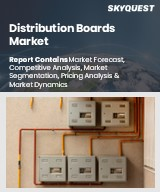
배전반 세계 시장 규모는 2023년에 48억 달러로 평가되었으며, 예측 기간(2025-2032년) 동안 CAGR 5.3%로, 2024년 50억 5,000만 달러에서 2032년에는 76억 4,000만 달러로 성장할 전망입니다.
세계 배전반 시장은 인프라 프로젝트가 확대되면서 효율적인 배전 및 지속가능한 운영에 대한 수요가 증가함에 따라 크게 성장하고 있습니다. 시설 관리자들은 에너지 손실을 최소화하고 신뢰할 수 있는 서비스를 제공하는 솔루션을 찾고 있으며, 주요 유통업체들은 스마트 센서와 자동 제어를 제품에 통합하도록 유도하고 있습니다. 이러한 진화는 배전반을 수동적인 부품에서 능동적인 관리 허브로 전환하고 전기 장비에 인텔리전스를 주입하는 업계의 추세와 일치합니다. 주요 진화에는 실시간 모니터링을 위한 IoT 플랫폼의 통합, 고장 격리를 개선하기 위해 기계식 장치를 디지털 회로 차단기로 교체, 예지보전을 위한 디지털 트윈의 활용 등이 있습니다. 또한, 모듈식 레이아웃과 사용자 정의 가능한 아키텍처는 설치 속도와 확장성을 향상시켜 궁극적으로 기대되는 성능을 재정의하고 있습니다.
Global Distribution Boards Market size was valued at USD 4.8 billion in 2023 and is poised to grow from USD 5.05 billion in 2024 to USD 7.64 billion by 2032, growing at a CAGR of 5.3% during the forecast period (2025-2032).
The global distribution boards market is experiencing significant growth driven by the rising demand for efficient power distribution and sustainable operations amid expanding infrastructure projects. Facility managers seek solutions that minimize energy losses and provide reliable service, prompting leading distributors to integrate smart sensors and automated controls into their offerings. This evolution transforms distribution boards from passive components into proactive management hubs, aligning with the industry's trend of infusing intelligence into electrical equipment. Key advancements include the integration of IoT platforms for real-time monitoring, the replacement of mechanical units with digital circuit breakers for improved fault isolation, and the use of digital twins for predictive maintenance. Additionally, modular layouts and customizable architectures are enhancing installation speed and scalability, ultimately redefining performance expectations.
Top-down and bottom-up approaches were used to estimate and validate the size of the Global Distribution Boards market and to estimate the size of various other dependent submarkets. The research methodology used to estimate the market size includes the following details: The key players in the market were identified through secondary research, and their market shares in the respective regions were determined through primary and secondary research. This entire procedure includes the study of the annual and financial reports of the top market players and extensive interviews for key insights from industry leaders such as CEOs, VPs, directors, and marketing executives. All percentage shares split, and breakdowns were determined using secondary sources and verified through Primary sources. All possible parameters that affect the markets covered in this research study have been accounted for, viewed in extensive detail, verified through primary research, and analyzed to get the final quantitative and qualitative data.
Global Distribution Boards Market Segments Analysis
Global Distribution Boards Market is segmented by Voltage Rating, End user and region. Based on Voltage Rating, the market is segmented into Low Voltage (Up to 1 kV), Medium Voltage (1 kV - 35 kV) and High Voltage (Above 35 kV). Based on End user, the market is segmented into Residential, Commercial, Industrial, Utilities and Data Centres. Based on region, the market is segmented into North America, Europe, Asia Pacific, Latin America and Middle East & Africa.
Driver of the Global Distribution Boards Market
The global distribution boards market is experiencing significant growth driven by the shift toward smart buildings and factories. This demand is fueled by the integration of advanced features in distribution boards, such as smart metering, communication capabilities, and remote diagnostics, which enhance energy efficiency and reduce energy waste. As building owners and facility managers increasingly seek automated solutions with sophisticated functionalities for predictive maintenance and real-time management, the market is responding to these needs. This trend aligns with national priorities focused on improving energy efficiency and promoting operational transparency across various industries, further bolstering the market's expansion.
Restraints in the Global Distribution Boards Market
The Global Distribution Boards market faces certain restraints primarily due to the high initial costs associated with advanced distribution boards featuring smart functionalities, which can be a significant burden for smaller users and emerging infrastructure projects. Additionally, the installation of these sophisticated systems often necessitates specialized labor, system redesign, and other related tasks, further escalating expenses. Over time, ongoing costs may rise as these systems require regular updates and recalibration. This financial burden can hinder their full implementation and acceptance, particularly in budget-conscious sectors where cost constraints are a major concern.
Market Trends of the Global Distribution Boards Market
The Global Distribution Boards market is witnessing a notable shift towards the convergence of digital intelligence with IoT functionality, transforming traditional distribution boards into intelligent energy hubs. This evolution allows for the integration of IoT sensors and real-time data interfaces, facilitating predictive maintenance, load forecasting, and remote diagnostics. Consequently, utilities and facility managers are increasingly adopting condition-based servicing over reactive strategies, which not only minimizes downtime but also enhances asset longevity. This trend aligns with the growing demand for transparency and accountability in energy consumption across various sectors, reflecting a significant market evolution towards smarter, data-driven solutions.